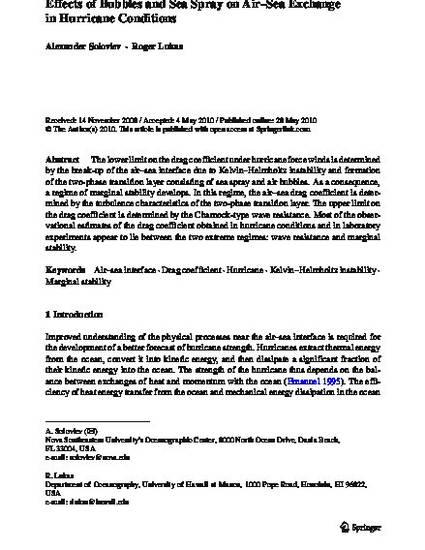
Article
Effects of Bubbles and Sea Spray on Air–Sea Exchange in Hurricane Conditions
Boundary-Layer Meteorology
ORCID
0000-0001-6519-1547
Document Type
Article
Publication Date
9-1-2010
Keywords
- Air-Sea interface,
- Drag coefficient,
- Hurricane,
- Kelvin-Helmholtz instability,
- Marginal stability
Abstract
The lower limit on the drag coefficient under hurricane force winds is determined by the break-up of the air–sea interface due to Kelvin–Helmholtz instability and formation of the two-phase transition layer consisting of sea spray and air bubbles. As a consequence, a regime of marginal stability develops. In this regime, the air–sea drag coefficient is determined by the turbulence characteristics of the two-phase transition layer. The upper limit on the drag coefficient is determined by the Charnock-type wave resistance. Most of the observational estimates of the drag coefficient obtained in hurricane conditions and in laboratory experiments appear to lie between the two extreme regimes: wave resistance and marginal stability.
DOI
10.1007/s10546-010-9505-0
Additional Comments
National Science Foundation grant #: OCE-0752606
Disciplines
Citation Information
Alexander Soloviev and Roger Lukas. "Effects of Bubbles and Sea Spray on Air–Sea Exchange in Hurricane Conditions" Boundary-Layer Meteorology Vol. 136 Iss. 3 (2010) p. 365 - 376 ISSN: 0006-8314 Available at: http://works.bepress.com/alexander-soloviev/54/

©The Author(s) 2010.
The final publication is available at Springer via http://dx.doi.org/10.1007/s10546-010-9505-0